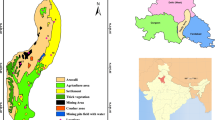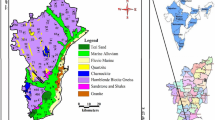Abstract
Groundwater is an important source of freshwater for domestic, agricultural and industrial uses in Iran. Groundwater quality assessment and environmental evaluation are considered as critical issues in recent years. Intensive human activities have resulted in significant changes in environment leading to serious groundwater contamination. This research proposes a two-part systematic approach to tackle heavy metals contamination problem in Rayen Basin (southeast Iran). The first part consists of determining geochemical characteristics and evaluating groundwater quality through application of water quality index and heavy metal pollution indices (i.e. HPI and MI). The second part includes ranking sampling stations based on heavy metals concentration in groundwater using linear assignment method. Six types of water could be identified according to the dominant cations and anions in samples: Ca–HCO3, Ca–SO4, Na–Cl, Na–HCO3, Na–SO4 and mixed water type. Calculation of indices revealed that natural and anthropogenic activities are playing a vital role in degrading groundwater quality in the study area. The proposed methodology can help in groundwater resource management and preventative activities by identifying risk factors and recognizing their pollution level. The results of this research provide useful and effective information for water pollution control and management and can be used in environmental studies in order to protect groundwater resources in the future.









Similar content being viewed by others
References
Aghanabati A (1993) Geology map of Rayen 1:250000 sheets. Geological Survey of Iran, Tehran, Iran
Ako AA, Shimada J, Hosono T, Kagabu M, Ayuk AR, Nkeng GE, Takem GEE, Takounjou ALF (2012) Spring water quality and usability in the Mount Cameroon area revealed by hydrogeochemistry. Environ Geochem Health. https://doi.org/10.1007/s10653-012-9453-3
Anderson MP (2014) Groundwater research and management: new directions and reinvention. In: Taniguchi M, Hiyama T (eds) Groundwater as a key for adaptation to changing climate and society. Springer, Tokyo, pp 1–15
Ardani R, Yari AR, Fahiminia M, Hashemi S, Fahiminia V, Saberi Bidgoli M (2015) Assessment of influence of landfill leachate on groundwater quality: a case study Albourz landfill (Qom, Iran). Arch Hyg Sci 4(1):13–21
Asgharpour MJ (1999) Multiple criteria decision making. University of Tehran, Tehran, p 397
Avvannavar SM, Shrihari S (2008) Evaluation of water quality index for drinking purposes for river Netravathi, Mangalore, South India. Environ Monitor Assess 143:279–290
Baghvand A, Nasrabadi T, Bidhendi GN, Vosoogh A, Karbassi A, Mehrdadi N (2010) Groundwater quality degradation of an aquifer in Iran central desert. Desalination 260(1–3):264–275
Barzegar R, Asghari Moghadam A, Kazemian N (2015) Assessment of heavy metals concentrations with emphasis on arsenic in the Tabriz plain aquifers, Iran. Environ Earth Sci 74:297–313
Benhaddya ML, Hadjel M (2013) Spatial distribution and contamination assessment of heavy metals in surface soils of Hassi Messaoud. Environ Earth Sci, Algeria. https://doi.org/10.1007/s12665-013-2552-3
Caerio S, Costa MH, Ramos TB, Fernandes F, Silveira N, Coimbra A, Painho M (2005) Assessing heavy metal contamination in Sado Estuary sediment: an index analysis approach. Ecol Indicat 5:155–169
Chaturvedi GB, Mishra BB, Tewari DD (2008) Water quality index of groundwaters near industrial areas of Balrampur, U.P. Nat Environ Pollut Technol 7(2):331–335
Cheboterev IJ (1955) Metamorphism of natural waters in the crust of weathering-I. Geochemica et cosmochima Acta 8(1–2):22–48
Colak M (2012) Heavy metal concentrations in sultana-cultivation soils and sultana raisins from Manisa (Turkey). Environ Earth Sci 67:695–712. https://doi.org/10.1007/s12665011-1511-0
Djokovic I, Dimitrijevic MN, Cvetic S (1996) Geology map of Rayen 1:100000 sheets. Geological Survey of Iran
Domenico PA, Schwartz FW (1990) Physical and chemical hydrogeology. Wiley, New York, p 824
Edet AE, Offiong OE (2002) Evaluation of water quality pollution indices for heavy metal contamination monitoring. A study case from Akpabuyo-Odukpani area, lower cross river Basin (Southeastern Nigeria). GeoJournal 57:295–304
Edmunds WM, Carrillo-Rivera JJ, Cardona A (2002) Geochemical evolution of groundwater beneath Mexico City. J Hydrol 258:1–24
Feilin Z, Ping-an Z, Ye-nan W, Yimeng S, Juan C, Benyou J (2017) SMAA-based stochastic multi-criteria decision making for reservoir flood control operation. J Stoch Environ Res Risk Assess 31:1485–1497. https://doi.org/10.1007/s00477-016-1253-3
Ghorbani M (2013) The economic geology of Iran: mineral deposits and natural resources. Springer, Berlin, p 572
Hwang CL, Yoon K (1981) Multiple attribute decision making: methods and applications: a state-of-the-art survey. Springer, New York
Jabbari N, Aminzadeh F, Barros PJ (2016) Hydraulic fracturing and the environment: risk assessment for groundwater contamination from well casing failure. DOI, J Stoch Environ Res Risk Assess. https://doi.org/10.1007/s00477-016-1280-0
Jiang XY, Cheng CQ (2009) Hydrochemical classification and identification of groundwater in mining region using multivariate statistical analysis. Hydrogeol Eng Geol 4:16–20 (in Chinese)
Joodavi A, Zare M, Mahootchi M (2015) Development and application of a stochastic optimization model for groundwater management: crop pattern and conjunctive use consideration. J Stoch Environ Res Risk Assess. 29(6):1637–1648
Kong XM, Huang GH, Fan YR, Li YP, Zeng XT, Zhu Y (2017) Risk analysis for water resources management under dual uncertainties through factorial analysis and fuzzy random value-at-risk. J Stoch Environ Res Risk Assess. https://doi.org/10.1007/s00477-017-1382-3
Li YP, Huang GH (2013) Risk analysis and management for water resources systems. J Stoch Environ Res Risk Assess. 27:593–597. https://doi.org/10.1007/s00477-012-0625-6
Li PY, Wu SK (2009) Water quality evaluation based on fuzzy mathematics in Dongsheng coalfield investigation area in Inner Mongolia. Water Conserv Sci Technol Econ 15(9):789–791 (in Chinese)
Li PY, Wu Q, Wu JH (2010) Groundwater suitability for drinking and agricultural usage in Yinchuan Area, China. Int J Environ Sci 1(6):1241–1249
Li PY, Qian H, Wu JH (2011) Hydrochemical characteristics and evolution laws of drinking groundwater in Pengyang County, Ningxia, Northwest China. E J Chem 8(2):565–575. https://doi.org/10.1155/2011/472085
LINDO Systems Inc (2017) LINGO 17, Optimization modeling software for linear, nonlinear, and integer programming. http://www.lindo.com
Liu SC (2000) A fuzzy multiple attribute decision making approach for linear assignment problems. In: Fifth Asia Pacific decision sciences institute conference Waseda University, Tokyo, Japan, pp 24–27
Lyulko T, Ambalova T, Vasiljeva T (2001) To integrated water quality assessment in Latvia, MTM (Monitoring Tailor-Made) III. In: Proceedings of international workshop on information for sustainable water management, Netherlands, pp 449–452
Marcovecchio JE, Botte SE, Freije RH (2007) Heavy metals, major metals, trace elements. In: Nollet LM (ed) Handbook of water analysis, 2nd edn. CRC Press, London, pp 275–311
Maria-Alexandra H, Roman C, Ristoiu D, Popita G, Tanaselia C (2013) Assessing of water quality pollution indices for heavy metal contamination. A study case from Medias City ground waters. Agric Sci Pract 3–4:25–31
Merkel B, Planer-Friedrich B (2008) Groundwater geochemis try—a practical guide to modeling of natural and contaminated aquatic systems. Springer, Berlin
Mishra PC, Patel RK (2001) Study of the pollution load in the drinking water of Rairangpur, a small tribal dominated town of North Orissa. Indian J Environ Ecoplann 5(2):293–298
Mohan SV, Nithila P, Reddy SJ (1996) Estimation of heavy metal in drinking water and development of heavy metal pollution index. J Environ Sci Health A31:283–289
Piper AM (1944) A graphic procedure in the geochemical interpretation of water-analyses. Eos Trans Amer Geophys Union 25(6):914–928
Pomerol JC, Romero SB (2000) Multi-Criterion decision in management: principles and practice. Kluwer Academic, Dordrecht
Prasad B, Kumari S (2008) Heavy metal pollution index of groundwater of an abandoned open cast mine filled with fly ash: a case study. Mine Water Environ 27(4):265–267
Rezaei A, Hassani H (2017) Hydrogeochemistry study and groundwater quality assessment in the north of Isfahan, Iran. Environ Geochem Health. https://doi.org/10.1007/s10653-017-0003-x
Rowell DL (1994) Soil science: methods and applications. Longman and Scientific Technical, New York
Saaty TL, Vargas LG (1980) Decision, raking with the analytic network process: economic, political, social and technological applications with benefits, opportunities, costs and risks. Springer, New York
Siegel FR (2002) Environmental geochemistry of potentially toxic metals. Springer, Berlin
Srinivasamoorthy K, Chidambaram M, Prasanna MV, Vasanthavigar M, John Peter A, Anandhan P (2008) Identification of major sources controlling Groundwater Chemistry from a hard rock terrain—a case study from Mettur taluk, Salem district, Tamilnadu, India. J Earth Syst Sci 117(1):49–58
Srinivasamoorthy K, Gopinath M, Chidambaram S, Vasanthavigar M, Sarma VS (2014) Hydrochemical characterization and quality appraisal ofgroundwater from Pungar sub basin, Tamilnadu, India. J King Saud Univ Sci 26(1):37–52
Tamasi G, Cini R (2004) Heavy metals in drinking waters from Mount Amiata (Tuscany, Italy) Possible risks from arsenic for public health in the province of Siena. Sci Total Environ 327:41–51
Tang WZ, Ao L, Zhang H, Shan BQ (2013) Accumulation and risk of heavy metals in relation to agricultural intensification in the river sediments of agricultural regions. Environ Earth Sci. https://doi.org/10.1007/s12665-013-2779-z
Todd DK, Mays LW (2005) Ground-water hydrology. Wiley, New York
Vasanthavigar M, Srinivasamoorthy K, Vijayaragavan K, Rajiv Ganthi R, Chidambaram S, Anandhan P, Manivannan R, Vasudevan S (2010) Application of water quality index for groundwater quality assessment: Thirumanimuttar sub-basin, Tamilnadu, India. J Environ Monit Assess 171:595–609
Velea T, Gherghe L, Predic V, Krebs R (2009) Heavy metal contamination in the vicinity of an industrial area near Bucharest. Environ Sci Pollut Res 16(Suppl 1):S27–S32. https://doi.org/10.1007/s11356-008-0073-5
Wedepohl KH (1978) Hand book of Geochemistry Ex-Editor. Springer, New York, pp 11–15
World Health Organization (WHO) (2011) Guidelines for drinking water quality. WHO Press, Geneva
Wu JH, Li PY (2009) Comparison of a variety of osculating value methods in water quality assessment. Water Conserv Sci Techno Econ 16(5):481–483 (in Chinese)
Wu J, Sun Z (2015) Evaluation of shallow groundwater contamination and associated human health risk in an alluvial plain impacted by agricultural and industrial activities, Mid-west China. Expo Health. https://doi.org/10.1007/s12403-015-0170-x
Wu JH, Li PY, Qian H, Wei YN (2010) Comparative analysis of the evaluation methods for groundwater quality: as a case study for the Ningxia chemical plant I water source in Yinchuan City. J Water Resour Water Eng 21(2):147–149 (in Chinese)
Zeng B, Xin Zhang Z, Yang M (2017) Risk assessment of groundwater with multi-source pollution by a long-term monitoring programme for a large mining area. Int Biodeter Biodegr, pp 1–9 (In Press)
Zhen L, Chongqing X, Miao L, Guihuan Y, Xiang L, Yeping M (2016) Identification and assessment of water safety risk for groundwater recharge with reclaimed water in China. J Stoch Environ Res Risk Assess. https://doi.org/10.1007/s00477-016-1313-8
Acknowledgements
The authors would like to thank the Amirkabir University of Technology (Polytechnic Tehran) for supporting this research. The contributions of Adonis Fard Mousavi and Samira Rezaei are highly appreciated.
Author information
Authors and Affiliations
Corresponding author
Rights and permissions
About this article
Cite this article
Rezaei, A., Hassani, H., Hayati, M. et al. Risk assessment and ranking of heavy metals concentration in Iran’s Rayen groundwater basin using linear assignment method. Stoch Environ Res Risk Assess 32, 1317–1336 (2018). https://doi.org/10.1007/s00477-017-1477-x
Published:
Issue Date:
DOI: https://doi.org/10.1007/s00477-017-1477-x




